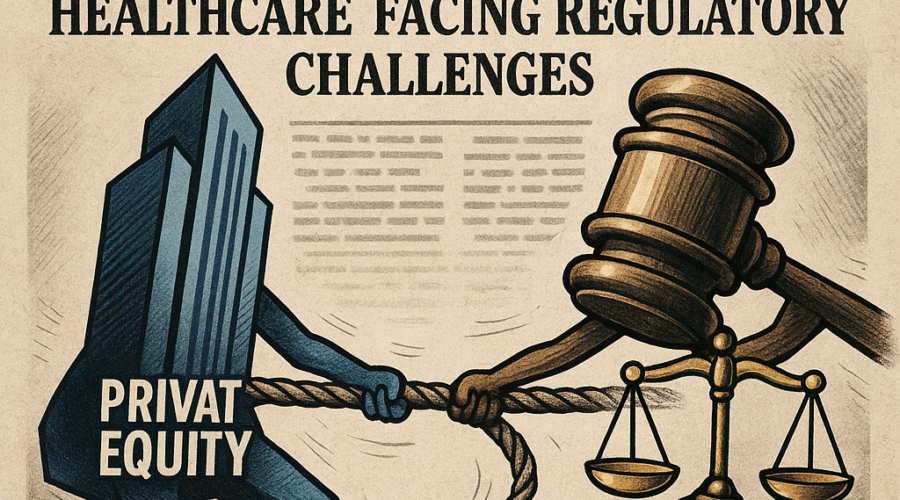Private equity firms poured over $115 billion into global healthcare acquisitions in 2024, marking the second-highest annual deal value on record despite rising interest rates and regulatory scrutiny[3][4]. Yet this aggressive expansion now faces unprecedented state-level resistance, with at least 15 states enacting legislation in 2025 to restrict corporate ownership of medical practices and hospitals following high-profile bankruptcies of private equity-backed health systems[9][13][18]. The collision between capital deployment and patient protection concerns is reshaping investment theses across outpatient services, behavioral health, and value-based care platforms, forcing sponsors to navigate fragmented regulatory landscapes while limited partners demand liquidity from aging healthcare assets[3][19].
💼 M&A / PE diligence in 24 hours? Yes, thanks to AI!
The Investment Thesis: Why Healthcare Attracted Private Equity
Structural Advantages in Fragmented Markets
Healthcare’s recession-resistant characteristics and predictable revenue streams created ideal conditions for private equity consolidation, particularly in specialized outpatient services where demographic tailwinds amplified returns[1][2]. The sector’s historical fragmentation enabled sponsors to aggregate regional physician practices across cardiology, orthopedics, and gastroenterology—specialties benefiting from Medicare’s payment policies favoring ambulatory surgical centers over hospital outpatient departments[1][4]. This consolidation strategy proved especially lucrative in behavioral health, where 60% of private equity deals since 2018 targeted mental health and substance use disorder providers capitalizing on Medicaid expansions and telehealth adoption[2][7].
Technology-Enabled Care Delivery
Digital health platforms became focal points for growth capital, with software-as-a-service models integrating clinical decision support and revenue cycle management attracting $104 billion in U.S. healthcare private equity investment during 2024 alone[3][4]. Artificial intelligence investments surged following FDA guidance clarifying regulatory pathways for diagnostic algorithms, while value-based care navigators promised margin expansion through risk-adjusted reimbursement models[1][5]. These technology enablers allowed sponsors to demonstrate operational improvements justifying premium valuations despite macroeconomic headwinds.
Documented Impacts on Care Delivery
Quality and Outcome Concerns
Peer-reviewed studies reveal troubling correlations between private equity ownership and clinical deterioration. A 2025 analysis of Medicare beneficiaries showed private equity hospital acquisition associated with a 2.7-percentage-point increase in 30-day postoperative mortality, while hospital-acquired conditions surged 25% compared to non-PE facilities[2][11]. Prospect Medical Holdings—owned by Leonard Green & Partners until 2021—exemplified these trends, extracting $457 million in dividends while its Pennsylvania hospitals subsequently required emergency funding to maintain basic supplies[16].
Economic Consequences
Cost inflation consistently accompanies private equity ownership according to systematic reviews, with allowed amounts per claim increasing following practice acquisitions[2][5]. This manifests through strategic payer mix shifts, as evidenced by Medicaid acceptance rates at PE-owned urology practices falling below non-PE counterparts[2][15]. The financial engineering extends to real estate strategies like sale-leaseback transactions, which burden operators with above-market rents while freeing capital for investor distributions—a practice now banned by Pennsylvania’s proposed Health System Protection Act[14][17].
The State Regulatory Backlash
Legislative Trends
Bipartisan momentum for healthcare transaction oversight produced 26 bills across 13 states in early 2025, with Massachusetts, Oregon, and Maine establishing the strictest frameworks[8][9][12]. Oregon’s Senate Bill 951 prohibits non-physician control of medical practices by closing corporate practice of medicine loopholes, while Maine’s temporary ban on private equity hospital acquisitions reflects concerns about rural access erosion[10][12]. These build upon existing notification regimes by adding attorney general approval requirements, as seen in Connecticut’s extension of review periods from 30 to 60 days[15][18].
Catalysts for Intervention
High-profile system failures drove legislative urgency. Steward Health Care’s 2024 bankruptcy—preceded by $1.3 billion in owner distributions—eliminated 2,400 jobs and closed five hospitals across Massachusetts, Florida and Ohio[17]. Similarly, Prospect Medical’s January 2025 Chapter 11 filing with $400 million debt followed Leonard Green’s dividend extraction, prompting a Senate committee to declare private equity’s financial model threatens “the nation’s health care infrastructure”[16][17]. State attorneys general now frame oversight as consumer protection, with Pennsylvania Governor Josh Shapiro condemning “corporate raiders like Prospect Medical Holdings prioritiz[ing] profits over patients”[14].
Industry Response and Market Evolution
Reputational Rehabilitation
Facing existential regulatory threats, sponsors launched the Association for Responsible Healthcare Investment in early 2025, promoting ethical guidelines emphasizing patient care preservation[9]. This coincides with operational pivots toward less-contested segments: home-based care platforms like Help at Home (backed by Centerbridge and Vistria) completed four add-on acquisitions in 2025, leveraging Medicare Advantage expansion to offset hospital sector scrutiny[7]. Sponsors also emphasize value-based care investments, positioning population health analytics as quality-enhancing amid criticism[1][5].
Deal Structuring Innovations
Transaction attorneys report rising physician-led acquisition vehicles using management services organization (MSO) models compliant with corporate practice restrictions[10][19]. These employ contractual control rather than direct ownership, though Oregon’s legislation specifically targets such arrangements[10]. For platform exits, secondary transactions dominate as strategics hesitate—Goldman Sachs’ purchase of Latticework Capital’s Xpress Wellness exemplifies sponsor-to-sponsor transfers avoiding regulatory reviews[3][19].
Market Outlook and Investment Implications
Near-Term Deal Flow
Healthcare private equity faces paradoxical pressures: record dry powder ($258 billion globally) conflicts with LP demands for liquidity from aging assets[3][4]. Add-on acquisitions dominate activity, comprising 59 of 94 tracked transactions in April 2025 as sponsors build regional density in behavioral health and home care[6][7]. Platform deals increasingly target carve-outs like Novo Holdings’ Catalent acquisition, which secured manufacturing capacity for GLP-1 therapies without triggering state reviews[3][5].
Sector-Specific Vulnerabilities
Regulatory risk concentrates in provider services, where 488 U.S. hospitals (8.5% of private facilities) now have private equity owners[20]. Apollo Global Management’s Lifepoint Health illustrates sector challenges—three North Carolina hospitals saw CMS star ratings downgraded in 2025, with one maintaining the lowest possible 1-star rating[20]. Conversely, healthcare IT and biopharma services face fewer ownership restrictions, attracting capital toward revenue cycle management and clinical trial infrastructure[3][4].
Conclusion: The Recalibration Ahead
The healthcare private equity landscape now bifurcates between restricted provider segments and open technology corridors, forcing sponsors to balance compliance against return thresholds. State attorneys general will likely expand enforcement tools through 2026, particularly targeting sale-leasebacks and dividend recapitalizations that divert resources from patient care[17][19]. Successful firms will emulate Help at Home’s community-integrated approach rather than Steward’s extractive model, demonstrating how operational improvements justify investor returns without compromising access or quality. As Massachusetts Health Policy Commission begins five-year monitoring of private equity transactions under its expanded authority, the industry’s capacity for self-regulation will determine whether further prohibitions emerge nationally[19].
Sources
https://www.afslaw.com/perspectives/health-care-counsel-blog/private-equity-investment-health-care-providers-and, https://achi.net/publications/private-equity-in-health-care/, https://www.bain.com/insights/year-in-review-and-outlook-global-healthcare-private-equity-report-2025/, https://www.cbh.com/insights/reports/private-equity-report-2024-trends-and-2025-outlook/, https://www.bain.com/insights/topics/global-healthcare-private-equity-report/, https://pestakeholder.org/news/private-equity-health-care-acquisitions-april-2025/, https://pestakeholder.org/news/private-equity-health-care-acquisitions-may-2025/, https://www.axios.com/2025/03/17/private-equity-health-care-state-legislation, https://www.beckersasc.com/private-equity/states-push-back-on-pe-ownership-in-healthcare-6-notes/, https://www.hklaw.com/en/news/intheheadlines/2025/05/oregon-bill-to-block-private-equity-medical-deals-heads, https://www.commonwealthfund.org/blog/2024/private-equity-health-care-looking-state-policy, https://www.youtube.com/watch?v=oKpGqYmiB6E, https://www.dlapiper.com/en-us/insights/publications/2025/06/states-impact-on-healthcare-transactions-and-private-equity-investment-2025, https://www.pa.gov/governor/newsroom/2025-press-releases/icymi--gov-shapiro-plan-stop-private-equity-gutting-health-care-.html, https://www.morganlewis.com/pubs/2025/04/state-legislatures-continued-focus-on-private-equity-transactions-in-healthcare, https://www.cbsnews.com/news/prospect-medical-holdings-bankruptcy-private-equity/, https://www.healthcaredive.com/news/steward-health-care-bankruptcy-one-year-anniversary/747348/, https://www.sidley.com/en/insights/newsupdates/2025/04/flurry-of-state-legislation-seeks-to-expand-the-us-healthcare, https://www.hklaw.com/en/insights/publications/2025/04/q2-2025-update-on-state-efforts-to-regulate-healthcare-consolidation, https://pestakeholder.org/news/pesp-updates-private-equity-hospital-tracker/





